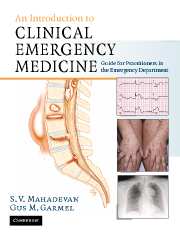Book contents
- Frontmatter
- Contents
- List of contributors
- Foreword
- Acknowledgments
- Dedication
- Section 1 Principles of Emergency Medicine
- Section 2 Primary Complaints
- 9 Abdominal pain
- 10 Abnormal behavior
- 11 Allergic reactions and anaphylactic syndromes
- 12 Altered mental status
- 13 Chest pain
- 14 Constipation
- 15 Crying and irritability
- 16 Diabetes-related emergencies
- 17 Diarrhea
- 18 Dizziness and vertigo
- 19 Ear pain, nosebleed and throat pain (ENT)
- 20 Extremity trauma
- 21 Eye pain, redness and visual loss
- 22 Fever in adults
- 23 Fever in children
- 24 Gastrointestinal bleeding
- 25 Headache
- 26 Hypertensive urgencies and emergencies
- 27 Joint pain
- 28 Low back pain
- 29 Pelvic pain
- 30 Rash
- 31 Scrotal pain
- 32 Seizures
- 33 Shortness of breath in adults
- 34 Shortness of breath in children
- 35 Syncope
- 36 Toxicologic emergencies
- 37 Urinary-related complaints
- 38 Vaginal bleeding
- 39 Vomiting
- 40 Weakness
- Section 3 Unique Issues in Emergency Medicine
- Section 4 Appendices
- Index
38 - Vaginal bleeding
Published online by Cambridge University Press: 27 October 2009
- Frontmatter
- Contents
- List of contributors
- Foreword
- Acknowledgments
- Dedication
- Section 1 Principles of Emergency Medicine
- Section 2 Primary Complaints
- 9 Abdominal pain
- 10 Abnormal behavior
- 11 Allergic reactions and anaphylactic syndromes
- 12 Altered mental status
- 13 Chest pain
- 14 Constipation
- 15 Crying and irritability
- 16 Diabetes-related emergencies
- 17 Diarrhea
- 18 Dizziness and vertigo
- 19 Ear pain, nosebleed and throat pain (ENT)
- 20 Extremity trauma
- 21 Eye pain, redness and visual loss
- 22 Fever in adults
- 23 Fever in children
- 24 Gastrointestinal bleeding
- 25 Headache
- 26 Hypertensive urgencies and emergencies
- 27 Joint pain
- 28 Low back pain
- 29 Pelvic pain
- 30 Rash
- 31 Scrotal pain
- 32 Seizures
- 33 Shortness of breath in adults
- 34 Shortness of breath in children
- 35 Syncope
- 36 Toxicologic emergencies
- 37 Urinary-related complaints
- 38 Vaginal bleeding
- 39 Vomiting
- 40 Weakness
- Section 3 Unique Issues in Emergency Medicine
- Section 4 Appendices
- Index
Summary
Scope of the problem
A common emergency department (ED) complaint is vaginal bleeding, accounting for up to 10% of ED visits in many centers. The differential diagnosis for vaginal bleeding is relatively short, with the most serious condition being ectopic pregnancy, and the most common conditions being threatened miscarriage in the pregnant patient and abnormal uterine bleeding (AUB) in the non-pregnant patient. According to the Centers for Disease Control and Prevention (CDC-P), there were 108,000 ectopic pregnancies reported in the US in 1992. Ectopic pregnancies account for approximately 2% of reported pregnancies. Threatened miscarriage occurs in 20–30% of all pregnancies, and up to 50% of those threatened will go on to spontaneously abort. Septic abortions and gestational trophoblastic disease must also be considered in the differential diagnosis of vaginal bleeding in a pregnant woman, accounting for 0.4–0.6 per 100,000 spontaneous miscarriages and 0.1–1% of pregnancies, respectively. An understanding of the definitions of the different classifications and management options for non-viable gestations is important for effective management in the ED and for communication with consultants. Second- and third-trimester bleeding and postpartum vaginal bleeding are not discussed in this chapter because these patients are routinely evaluated in labor and delivery areas and infrequently cared for by emergency physicians.
Not all women with vaginal bleeding are pregnant. In the reproductive years, AUB is defined as bleeding from the uterus that is irregular in amount, timing, or duration. Prior to menarche or following menopause, any uterine bleeding is considered abnormal.
- Type
- Chapter
- Information
- An Introduction to Clinical Emergency MedicineGuide for Practitioners in the Emergency Department, pp. 555 - 568Publisher: Cambridge University PressPrint publication year: 2005

